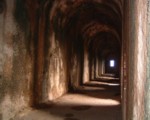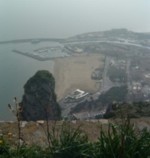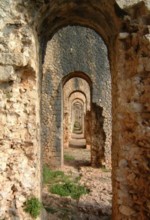The temple, or Roman sanctuary, above Terracina dates back to the fourth century BC, though much of the development belongs to the first and second centuries BC. The complex is large and spectacularly-situated, dominating the shoreline and sea. The sanctuary has long been assumed to have been dedicated to Jupiter, although Venus has been another suggestion.
Monte Sant’Angelo, 227m high, is the end of the Monti Ausoni mountain range. Descending straight to the sea, the mountain blocked the path of the Appian Way (Via Appia), which veered north of the summit until Trajan had the rock face cut to clear a route at sea level. This commanding position on a major communications route and above a port gave the site obvious significance, and the religious complex was designed on a large scale, to incorporate a military base.
The large complex consisted of several buildings constructed over several centuries. The principal temple would have dominated the skyline, sitting on a large platform above the arcaded substructure and accessed up twelve steps. Behind this building a colonnaded portico ran along the cliffs. At a short distance a smaller temple had its own levelled rocky base, while other features included an ‘oracle’s cave’, cisterns and military headquarters. A huge wall with nine towers protects the headland.

The most impressive remains are those of the vaulting at the base of the main temple area. A sequence of eleven arches provide a panoramic and striking cloister facing the sea, while on the landward side, the passage opens onto a 60m-long vaulted hall.
Later a medieval monastery was constructed over the temple remains, and a church dedicated to S. Michele Arcangelo (St. Michael) was established within the smaller temple. The ruined walls of several small rooms are all that remain of the monastery, which was abandoned by the end of the sixteenth century.
The complex covers a large area, which offers plenty of grassy picnic spots amidst the rock and the ruins. It’s free to enter, and there is a generous-sized car park outside the walls. A small bar with a sunny terrace and basking cats offers welcome refreshments, and has guidebooks for sale.

To walk to the temple from Piazza del Municipio in Terracina, first head a short way down the sloping street opposite the Duomo. Take the first left uphill by the two stone funerary lions, and continue upwards, following signs to ‘Tempio di Giove Anxur’. The main road winds back inland towards the town cemetery; the temple access road leads off to the right, and is pleasantly quiet as it curves up through flower-strewn olive groves. Detritus and empty wine bottles along the roadside indicate what the local youths drive up here for at night, but on a spring daytime we are untroubled by traffic, bar two boys filling their car with smoke of dubious provenance; they subsequently hurtle past us heading for town, weaving dangerously from one side of the road to the other. It’s an interesting walk uphill, past chunks of Roman stones, and picturesque views, but rather tiring in the heat of the day. Take some water to drink, and allow at least forty minutes.
Useful links
Lazio destinations
- About the Lazio region
- Anzio
- Bracciano
- Calcata
- Castel Gandolfo
- Castelli Romani
- Cerveteri
- Formia
- Frascati
- Gaeta
- Palestrina
- Pontine islands
- Ponza
- Rome
- Sperlonga
- Terracina
- Tivoli
- Ventotene
- Viterbo
